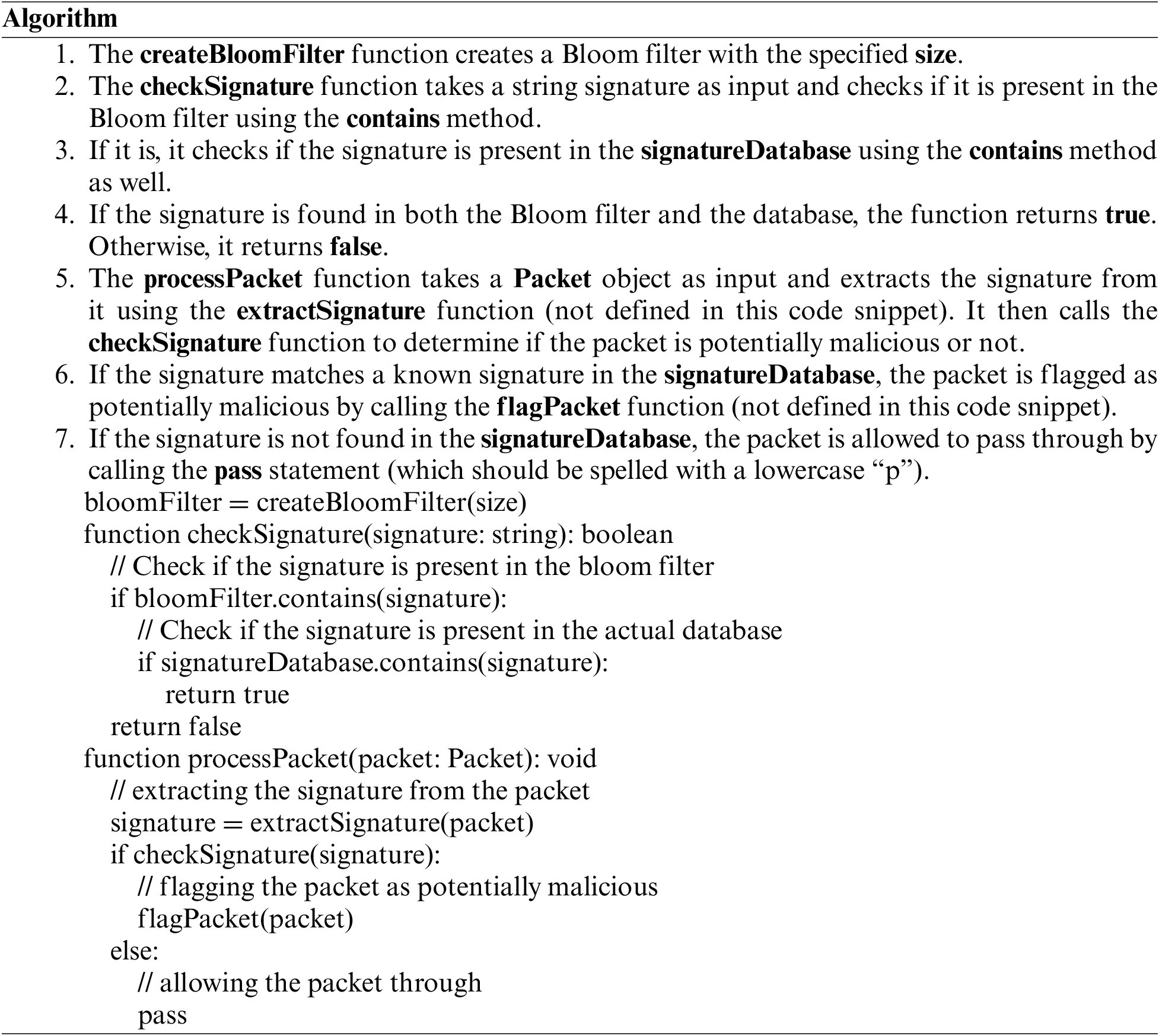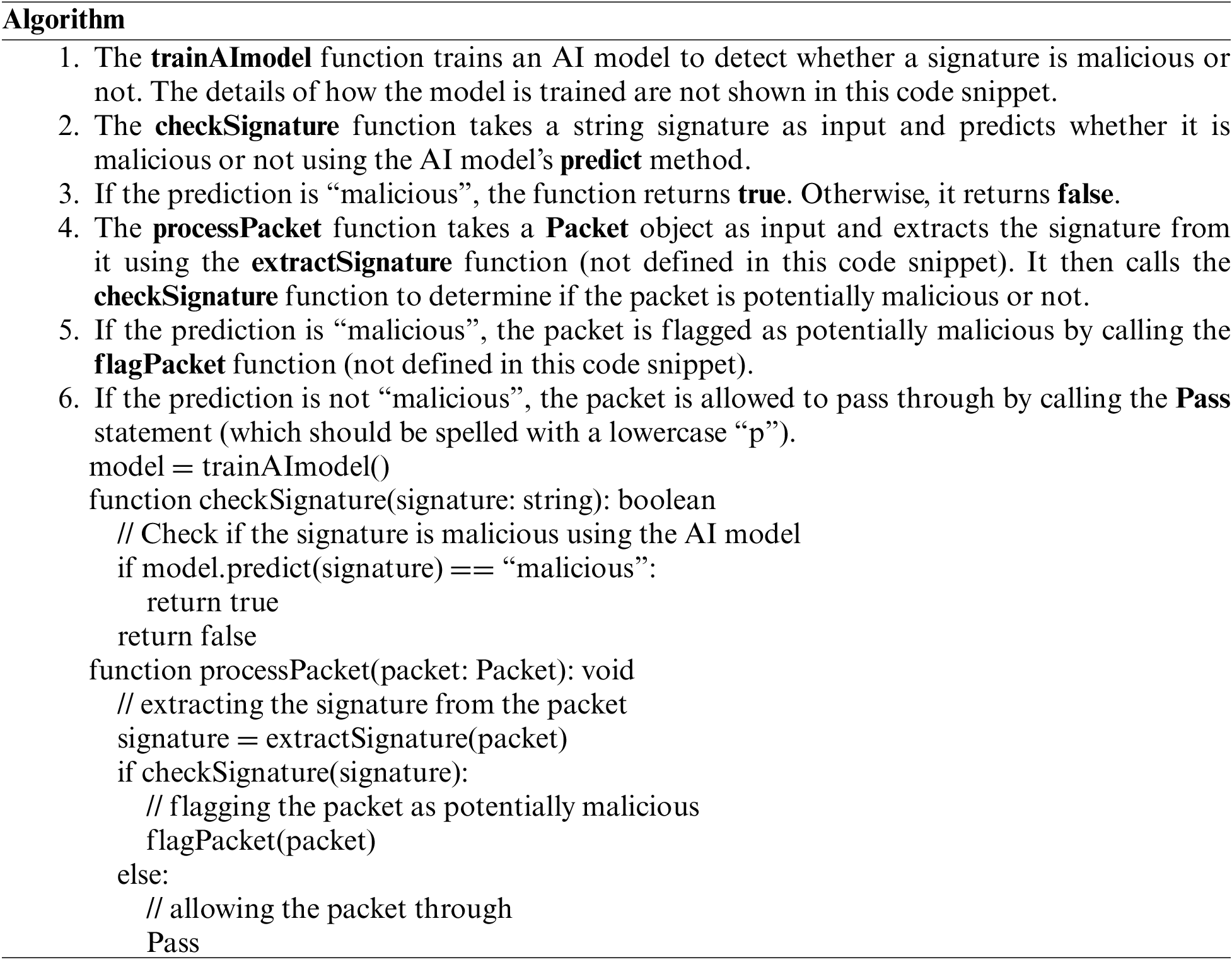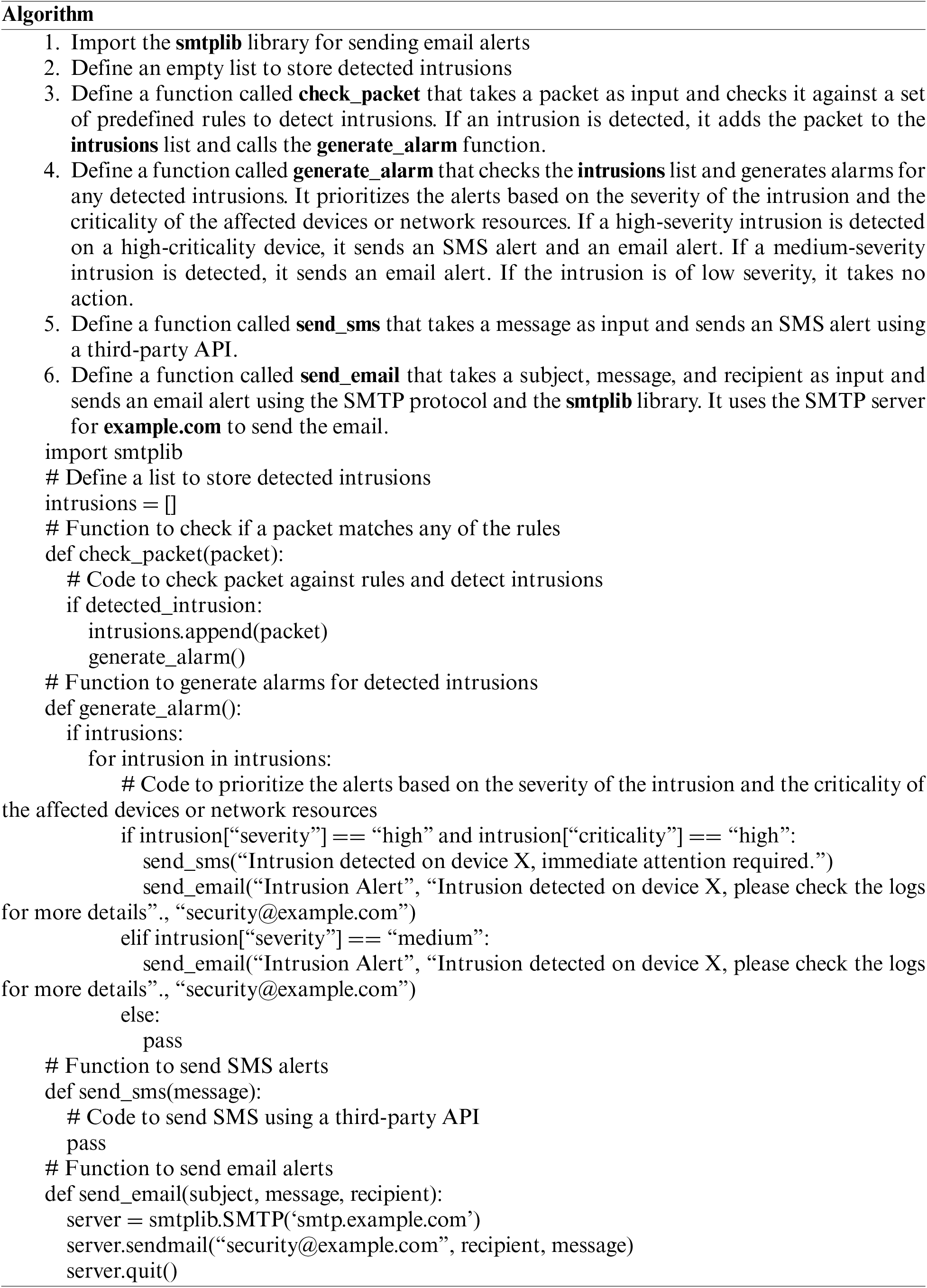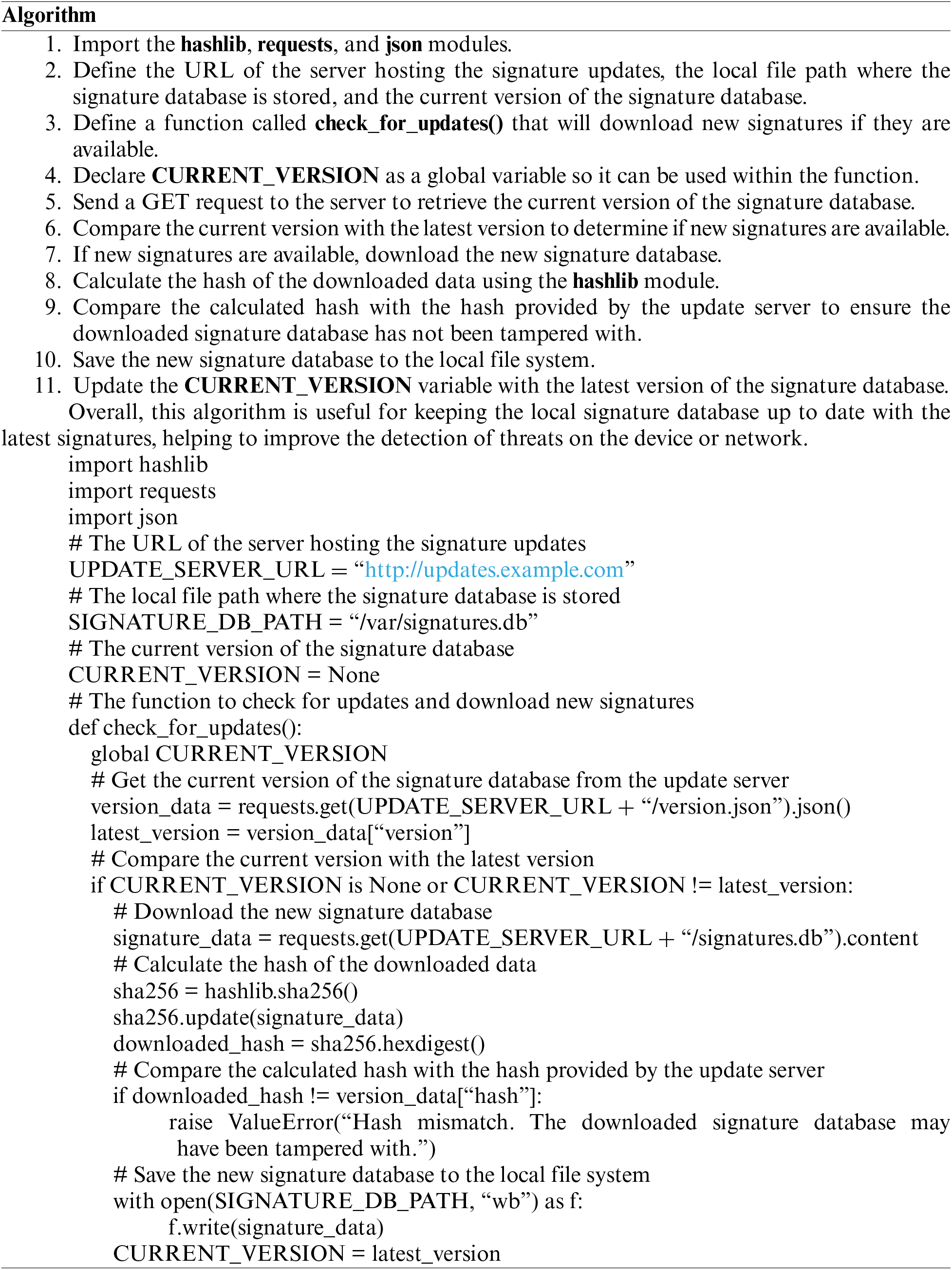 Open Access
Open Access
ARTICLE
Signature-Based Intrusion Detection System in Wireless 6G IoT Networks
1 University of Kashmir, Srinagar, 190003, India
2 Cluster University, Srinagar, 190008, India
* Corresponding Author: Mansoor Farooq. Email:
Journal on Internet of Things 2022, 4(3), 155-168. https://doi.org/10.32604/jiot.2022.039271
Received 19 January 2023; Accepted 10 April 2023; Issue published 12 June 2023
Abstract
An “Intrusion Detection System” (IDS) is a security measure designed to perceive and be aware of unauthorized access or malicious activity on a computer system or network. Signature-based IDSs employ an attack signature database to identify intrusions. This indicates that the system can only identify known attacks and cannot identify brand-new or unidentified assaults. In Wireless 6G IoT networks, signature-based IDSs can be useful to detect a wide range of known attacks such as viruses, worms, and Trojans. However, these networks have specific requirements and constraints, such as the need for real-time detection and low-power operation. To meet these requirements, the IDS algorithm should be designed to be efficient in terms of resource usage and should include a mechanism for updating the attack signatures to keep up with evolving threats. This paper provides a solution for a signature-based intrusion detection system in wireless 6G IoT Networks, in which three different algorithms were used and implemented by using python and JavaScript programming languages and an accuracy of 98.9% is achieved.Keywords
An “Intrusion Detection System” (IDS) is a security measure designed to perceive and be aware of unauthorized access or malicious activity on a computer system or network [1]. Intrusion Detection Systems can be divided into two main classes: signature-based and anomaly-based.
Signature-based IDSs employ an attack signature database to identify intrusions. This indicates that the system can only identify [1] known attacks and cannot identify brand-new or unidentified assaults. Signature-based IDSs are generally considered to [2] be less resource-intensive than anomaly-based IDSs, and they can be used to detect a wide range of attacks, such as viruses, worms, and Trojans.
Anomaly-based IDSs, on the other hand, use machine learning or statistical techniques to identify abnormal behaviour in a system or network. This means that the system can detect unknown attacks, but it requires a large amount of labelled data to train the model, and it may generate more false positives than signature-based IDSs.
For wireless IoT networks, it’s important to have a system that can detect intrusions in real-time, that can handle the high volume of data and can adapt to the resource-constrained environment of these networks.
The IDS algorithm should also include a mechanism for updating the attack signatures, and for generating alarms when an intrusion is detected [3]. Additionally, it should be able to handle false positives and false negatives and it should be able to send alerts to the appropriate personnel via email, SMS, or other remote communication methods.
Wireless IoT networks are networks that connect “Internet of Things” (IoT) devices to each other and the internet using wireless communication technologies. These networks are designed to support a wide range of devices, from simple sensors to complex industrial equipment.
One of the key characteristics of wireless IoT networks is their ability to support a large number of devices with limited resources [3]. This means that the devices in a wireless IoT network typically have limited processing power, memory, and battery life. To support these devices, wireless IoT networks use low-power wireless communication technologies such as Zigbee, Z-Wave, and LoRaWAN.
Wireless IoT networks can be split into two main classes: low-range and long-range networks. Low-range networks, such as Zigbee and Z-Wave, are typically used for home automation and building automation applications and have a [4] range of around 30 meters. Long-range networks, such as LoRaWAN and Sigfox, have a range of several kilometres and are typically used for industrial and agricultural applications.
2 Monitoring and Analysis of Network Traffic to Detect Malicious Activities
There are several ways to monitor and analyze network traffic to detect malicious activity in a wireless 6G IoT network, including:
• Signature-Based Detection: With this technique, network traffic is compared to a database of recognised harmful [4] patterns or signatures. The traffic is marked as possibly malicious if a match is discovered.
• Anomaly-Based Detection: This method involves monitoring network traffic for patterns or behaviors that deviate from what is considered normal. Any deviations from the norm are flagged as potentially malicious.
• Behavioral-Based Detection: With this technique, people and device behaviour on the network are examined for patterns that might point to malicious activities.
• Machine Learning-Based Detection: Using machine learning techniques, this technique analyses network data in real-time for [5] patterns that might point to malicious behaviour.
• Traffic Flow Analysis: This method involves collecting and analyzing network traffic data to understand the flow of data across the network, identify any anomalies and suspicious connections.
• Security Information and Event Management (SIEM): Which may be used to track and examine data from many sources, including firewall logs and warnings from intrusion [6] detection systems, in order to find possible security concerns.
• Virtualized Network Function (VNF): In 6G networks, which can be used to provide a more dynamic and programmable way to monitor, analyze and protect the network.
3 Signature-Based Intrusion Detection System
Signature-based detection is a method of identifying malicious activity [7] in a wireless 6G IoT network by comparing network traffic to a database of known malicious patterns or signatures. The process works by analyzing network packets and comparing them to a database of known malicious patterns, such as specific strings of data or specific instructions in a packet header. The traffic is marked as possibly malicious if a match is discovered.
The following steps outline the general process of how signature-based detection works:
• Signature Database: A database of known malicious patterns or signatures is created and maintained. This database can include information [8] such as specific strings of data, specific instructions in a packet header, or known malware signatures.
• Alarm Generation: If a match is found, an alarm is generated to alert the security team. This alarm can also trigger an automatic [9] response to block or isolate suspicious devices or traffic.
• Signature Updates: The signature database is updated regularly to protect against newly discovered threats.
3.1 Algorithm for Signature Database
The algorithm used for the signature database in a wireless IoT network depends on the specific requirements of the system and the type of data being stored. However, some commonly used algorithms for signature databases include:
These algorithms use a mathematical function, called a hash function, to create a unique value, called a hash, for each signature in the database. The hash function takes the signature as input and produces a fixed-size string of characters as output. By comparing the hash of a new signature to the hash of known signatures in the database, the system can quickly identify a match.

These algorithms use techniques such as regular expressions or string matching to identify patterns in the data that match known signatures.

The Bloom filter is a probabilistic data structure that is utilised by this method to determine if an element is a part of a set. It is used to improve the speed of searching the signature database.

3.1.4 Trie-Based Data Structures
Trie is a tree-based data structure that is used to store the signature database, it allows for efficient lookups and prefix-based search.

3.1.5 Artificial Intelligence-Based algorithms
These algorithm uses machine learning techniques to generate and update the signature database. They may be used to network traffic analysis to spot novel patterns that could point to malicious behaviour.

This algorithm is a combination of multiple algorithms, it can integrate the advantages of different algorithms to improve the accuracy, robustness, and scalability of the signature database. The Table 1 below will provide the accuracy of the all the algorithms of signature based intrusion detection as discussed with achieved accuracy of more than 98.9%.


3.2 Algorithm for Alarm Generation for IDS in Wireless 6G IoT Networks
The Alarm Generation algorithm for IDS in wireless 6G IoT networks would need to consider the specific requirements and constraints [10] of this type of network. Here are a few examples of how this algorithm could be implemented:
1. Real-time Alerts: In wireless 6G IoT networks, it is important to generate alarms in real-time to minimize the impact of intrusions. The alarm generation algorithm [11] should be designed to generate alerts as soon as an intrusion is detected, rather than waiting for a batch of intrusions to be detected.
2. Prioritization: Since wireless 6G IoT networks have a large number of connected devices and generate a high volume of data, it’s important to prioritize [12] the alerts based on the severity of the intrusion and the criticality of the affected devices or network resources.
3. Remote Management: Many wireless 6G IoT networks are deployed in remote or hard-to-reach locations. The alarm generation algorithm should be [13] designed to send alerts to the appropriate personnel via email, SMS, or other remote communication methods.
4. Handling False Positives: A rule-based or machine learning-based intrusion detection algorithm can generate false positives. The alarm generation algorithm should be designed to handle false positives by providing a mechanism for the system [14] administrator or security analyst to verify and clear the alarm.
5. Compliance and Auditing: The alarm generation algorithm should be designed to generate alarms that comply with industry regulations and [14] standards and that can be audited for compliance purposes

3.3 Algorithm for Signature Update for IDS in Wireless IoT Networks
The Signature Update algorithm is an important aspect of any signature-based intrusion detection system (IDS) as it ensures that the system [13] is able to detect new and evolving threats.
Here are a few examples of how the Signature Update algorithm could be implemented for IDS in wireless IoT networks:
1. Automatic Updates: The algorithm should be designed to automatically download and install new signature updates from a centralized server or [15] cloud-based service. This ensures that the system is always up-to-date with the latest threats.
2. Scheduled Updates: The algorithm should be designed to schedule regular updates at specific times, such as during off-peak hours or when the [16–18] network is less busy. This minimizes the impact of updates on network performance and availability.
3. Incremental Updates: The algorithm should be designed to only download and install the updated signatures that are required, rather than downloading and installing the entire signature database. This reduces the amount of bandwidth and storage [19–21] required for updates.
4. Rollback Capabilities: The algorithm should be designed to include rollback capabilities [22] so that the system can revert to a previous version of the signature database if an update cause problem.
5. Authentication: The algorithm should be designed to include authentication mechanisms to ensure that only authorized updates are applied to the system, this can be done by using a [23] digital signature or encryption.

The algorithms show a promising result with an achieved accuracy of 98.9% for detecting various malicious activities in IDS as shown in Table 2. The algorithms devised here in this study highly improve the overall efficacy of the system. The same algorithms can be implemented for various intrusion detection systems in order to uncover various hidden malicious threats or activities that are degenerating detection systems with overall prodigious accuracy and results as shown in Fig. 1.


Figure 1: Shows the comparison between Existing Results and New results
In Conclusion, an IDS is a security measure that monitors a computer system or network for unauthorized access or malicious activity, it can be signature-based or anomaly-based. A Signature-based Intrusion Detection System (IDS) in wireless 6G IoT networks is used to measure security that uses a pre-defined set of known malicious patterns or signatures to identify and flag potentially harmful packets. The system compares the incoming packets against the pre-defined signatures in a database, with the help of various techniques and if a match is found, the packet is flagged as potentially malicious. The advantages of using a Signature-based IDS in wireless 6G IoT networks include:
• High detection rate for known threats
• Low false positive rate
• Easy to deploy and maintain
• Can be used in conjunction with other security measures
It’s important to note that the use of a Signature-based IDS alone may not provide enough protection, and it’s recommended to use a combination of different security measures such as machine learning-based detection to improve the overall security of wireless 6G IoT networks.
Funding Statement: The authors received no specific funding for this study.
Conflicts of Interest: The authors declare that they have no conflicts of interest to report regarding the present study.
References
1. R. G. Bace and P. Mell, “Intrusion detection systems,” 2001. http://cs.uccs.edu/~cchow/pub/ids/NISTsp800-31.pdf. [Google Scholar]
2. S. Axelsson, Intrusion detection systems: A survey and taxonomy. 2000. https://citeseerx.ist.psu.edu/document?repid=rep1&type=pdf&doi=7a15948bdcb530e2c1deedd8d22dd9b54788a634. [Google Scholar]
3. A. Khraisat, I. Gondal, P. Vamplew and J. Kamruzzaman, “Survey of intrusion detection systems: Techniques, datasets and challenges,” Cybersecurity, vol. 2, no. 1, pp. 1–22, 2019. [Google Scholar]
4. C. Kruegel and T. Toth, “Using decision trees to improve signature-based intrusion detection,” in Int. Workshop on Recent Advances in Intrusion Detection, Berlin, Heidelberg, Springer, pp. 173–191, 2003. [Google Scholar]
5. V. Kumar and O. P. Sangwan, “Signature based intrusion detection system using SNORT,” International Journal of Computer Applications & Information Technology, vol. 1, no. 3, pp. 35–41, 2012. [Google Scholar]
6. N. Hubballi and V. Suryanarayanan, “False alarm minimization techniques in signature-based intrusion detection systems: A survey,” Computer Communications, vol. 49, pp. 1–17, 2014. [Google Scholar]
7. M. Farooq and M. Hassan, “IoT smart homes security challenges and solution,” International Journal of Security and Networks, vol. 16, no. 4, pp. 235–243, 2021. [Google Scholar]
8. M. Farooq, “Supervised learning techniques for intrusion detection system based on multi-layer classification approach,” International Journal of Advanced Computer Science and Applications, vol. 13, no. 3, pp. 311–315 2022. [Google Scholar]
9. H. G. Kayacik, A. N. Zincir-Heywood and M. I. Heywood, “Intrusion detection systems,” in Encyclopedia of Multimedia Technology and Networking, Pennsylvania: IGI Global, pp. 494–499, 2005. [Google Scholar]
10. A. Shenfield, D. Day and A. Ayesh, “Intelligent intrusion detection systems using artificial neural networks,” ICT Express, vol. 4, no. 2, pp. 95–99, 2018. [Google Scholar]
11. A. Khraisat, I. Gondal, P. Vamplew and J. Kamruzzaman, “Survey of intrusion detection systems: Techniques, datasets and challenges,” Cybersecurity, vol. 2, no. 1, pp. 1–22, 2019. [Google Scholar]
12. D. Anderson, T. Frivold and A. Valdes, “Next-generation intrusion detection expert system (NIDESA summary,” 1995. [Google Scholar]
13. F. Jemili, M. Zaghdoud and M. B. Ahmed, “A framework for an adaptive intrusion detection system using Bayesian network,” in 2007 IEEE Intelligence and Security Informatics, Piscataway, IEEE, pp. 66–70, 2007. [Google Scholar]
14. T. Fukač, V. Košař, J. Kořenek and J. Matoušek, “Increasing throughput of intrusion detection systems by hash-based short string pre-filter,” in 2020 IEEE 45th Conf. on Local Computer Networks (LCN), Piscataway, IEEE, pp. 509–514, 2020. [Google Scholar]
15. B. Groza and P. S. Murvay, “Efficient intrusion detection with bloom filtering in controller area networks,” IEEE Transactions on Information Forensics and Security, vol. 14, no. 4, pp. 1037–1051, 2018. [Google Scholar]
16. C. Ghasemi, H. Yousefi, K. G. Shin and B. Zhang, “On the granularity of trie-based data structures for name lookups and updates,” IEEE/ACM Transactions on Networking, vol. 27, no. 2, pp. 777–789, 2019. [Google Scholar]
17. B. M. Aslahi-Shahri, R. Rahmani, M. Chizari, A. Maralani, M. Eslami et al., “A hybrid method consisting of GA and SVM for intrusion detection system,” Neural Computing and Applications, vol. 27, no. 6, pp. 1669–1676, 2016. [Google Scholar]
18. W. Chimphlee, A. HananAbdullah, M. N. M. Sap, S. Chimphlee and S. Srinoy, “A rough-fuzzy hybrid algorithm for computer intrusion detection,” a a, 2, 1, 2005. [Google Scholar]
19. T. AbuHmed, A. Mohaisen and D. Nyang, “A survey on deep packet inspection for intrusion detection systems,” ArXiv preprint arXiv: 0803.0037, 2008. [Google Scholar]
20. M. Sarhan, S. Layeghy and M. Portmann, “Evaluating standard feature sets towards increased generalisability and explainability of ML-based network intrusion detection,” Big Data Research, vol. 30, pp. 100359, 2022. [Google Scholar]
21. G. Singh and N. Khare, “A survey of intrusion detection from the perspective of intrusion datasets and machine learning techniques,” International Journal of Computers and Applications, vol. 44, no. 7, pp. 659–669, 2022. [Google Scholar]
22. E. Rehman, M. Haseeb-ud-Din, A. J. Malik, T. K. Khan, A. A. Abbasi et al., “Intrusion detection based on machine learning in the internet of things, attacks and counter measures,” The Journal of Supercomputing, vol. 78, pp. 1–35, 2022. [Google Scholar]
23. R. Ahmad, I. Alsmadi, W. Alhamdani and L. A. Tawalbeh, “Towards building data analytics benchmarks for IoT intrusion detection,” Cluster Computing, vol. 25, no. 3, pp. 2125–2141, 2022. [Google Scholar]
Cite This Article
 Copyright © 2022 The Author(s). Published by Tech Science Press.
Copyright © 2022 The Author(s). Published by Tech Science Press.This work is licensed under a Creative Commons Attribution 4.0 International License , which permits unrestricted use, distribution, and reproduction in any medium, provided the original work is properly cited.


 Submit a Paper
Submit a Paper Propose a Special lssue
Propose a Special lssue View Full Text
View Full Text Download PDF
Download PDF Downloads
Downloads
 Citation Tools
Citation Tools